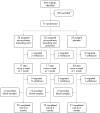Micronutrients (including zinc) reduce diarrhoea in children: the Pakistan Sprinkles Diarrhoea Study
- PMID: 16556612
- PMCID: PMC2082848
- DOI: 10.1136/adc.2005.086199
Micronutrients (including zinc) reduce diarrhoea in children: the Pakistan Sprinkles Diarrhoea Study
Abstract
Aims: To examine the effect of the daily use of micronutrients (including zinc) or the same micronutrients plus heat inactivated lactic acid bacteria (LAB), on diarrhoea in children compared to placebo.
Methods: A triple blind randomised clinical trial in an urban slum of Karachi, Pakistan. Micronutrients (including zinc), micronutrients (including zinc and LAB), or placebo, were provided daily for two months to 75 young children (aged 6-12 months) identified at high risk for diarrhoea related mortality on the basis of history of at least one episode of diarrhoea in the preceding two weeks. The longitudinal prevalence of diarrhoea was defined as the percentage of days a child had diarrhoea out of the days the child was observed.
Results: Mean longitudinal prevalence of diarrhoea in the micronutrient-zinc group was 15% (SD = 10%) child-days compared to 26% (SD = 20%) child-days in the placebo group and 26% (SD = 19%) child-days in the micronutrient-zinc-LAB group. The difference between the micronutrient-zinc-LAB and placebo groups was not significant.
Conclusion: The daily provision of micronutrients (including zinc) reduces the longitudinal prevalence of diarrhoea and thus may also reduce diarrhoea related mortality in young children; heat inactivated LAB has negative effects in these children.
Conflict of interest statement
Competing interests: S Zlotkin owns the intellectual property rights to micronutrient Sprinkles. Any profit net of expenses generated from licensing agreements for the production of Sprinkles is donated to the Hospital for Sick Children Foundation.
References
-
- Yousafzai M, Bhutta Z.Contemporary issues in childhood diarrhoea and malnutrition. Karachi: Oxford University Press, 2000
-
- Henry F. The epidemiologic importance of dysentery in communities. Rev Infect Dis 199113S238–S244. - PubMed
Publication types
MeSH terms
Substances
LinkOut - more resources
Full Text Sources
Miscellaneous


